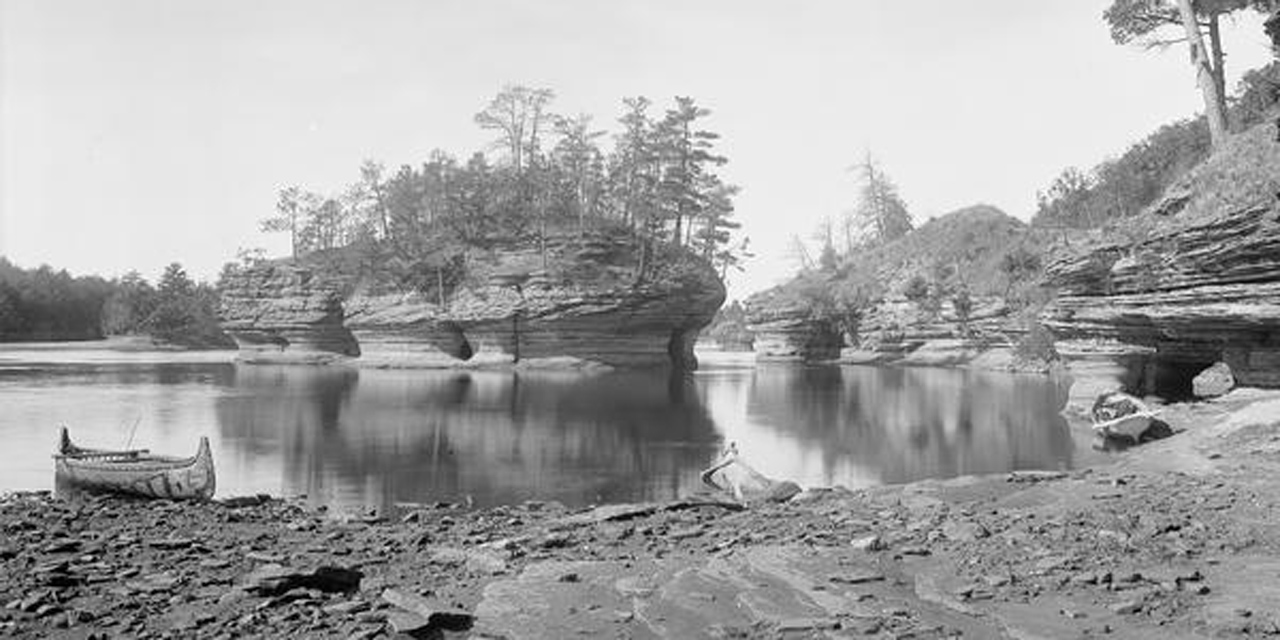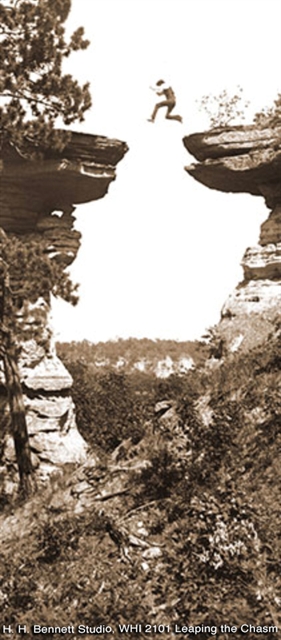Wisconsin Dells History

From logging town to steamboat tour central to "The Waterpark Capital of the World!®"
Author: Carla Minsky
Original Published Date: February 18, 2015
Today’s toddlers, tweens and teenagers think of Wisconsin Dells as a shiny, new vacation spot. Little do they know that the Dells is over 150 years old! It was back in 1856 that Wisconsin Dells, then known as Kilbourn City in honor of the railroad’s president, was incorporated.

500 Million Years Ago
You'll be amazed how we can effectively condense 500 million years of history into a paragraph or two. But this is important, because you have to look that far back to understand how Wisconsin Dells came to be what it is today. During the Cambrian Period, this community was the sandy shore of an ancient sea. Over time, the sand was compacted, and percolating groundwater cemented the sand into rock. That rock went virtually untouched for millions of years. Are your eyes glazing over yet? No? O.K., good, let's continue.
Fast forward, way forward, to 19,000 years ago, when a glacier extended to within four miles east of the area, never touching the Dells. That glacier melted about 15,000 years ago and formed Glacial Lake Wisconsin, a lake about the size of Utah's Great Salt Lake and as deep as 150 feet. The last ice that held back the waters of Glacial Lake Wisconsin began to melt. The failed ice dam unleashed a catastrophic flood; the lake's depth dropped to 50 feet. The meltwaters cut deep, narrow gorges and unusual rock formations into the sandstone and formed the steep-sided canyons and bluffs you see today lining the Wisconsin River. The flood most likely cut the gorges in the Dells in a matter of days or weeks as the swift water eroded away the soft sandstone.

Native American Roots - A History That Should Be Required Reading
An entire book could be devoted to the history of the Native American culture in Wisconsin Dells. The area has been inhabited by native people for 2,000 years, and probably longer. You see their spirit in petroglyphs and pictographs carved and painted into local rock formations, and in ceremonial and burial mounds. While nearly all of the mounds have been destroyed by farming and floods, you can still find some examples of this ancient culture known as the "Effigy Mound Builders." One treasure is at the Kingsley Bend Wayside on Highway 16 where there are a group of some 20 burial and effigy mounds, including two 100-foot long bears, a panther with a tail as long as a football field, and an eagle with a 200 foot wingspan.
The history of the Ho-Chunk, the largest Native American Nation in Wisconsin Dells, once called Winnebago by the French fur traders, includes immense hardship and tremendous rebuilding. In 1832, the U.S. Government began its infamous removal policy, stating that all Indians must be moved west of the Mississippi River. A series of deadly conflicts deeply scarred the culture. The Ho-Chunk were forced to leave their land and head to northwestern Iowa and south-central Minnesota. They were again moved in 1863 to a desolate reservation in South Dakota. It wasn’t until 1873, when the removal policy was reversed, that the Ho-Chunk could file claims to land in the area. By then, Wisconsin Dells had already become a site for Ho-Chunk pow-wows and dancing, with tourists coming to enjoy the festivals and appreciate the culture.
Today, the 4,900 members of the Ho-Chunk Sovereign Nation hold title to 2,000 acres of land, continuing anew their dedication to preserve the Ho-Chunk culture.
The Birth of the Dells
In 1856, the town was incorporated as Kilbourn City, in honor of the railroad's president. The name did not stick. In 1931, it was officially changed to Wisconsin Dells, the name the locals and tourists had always used, with "Wisconsin" derived from the Native American word meaning "dark rushing waters," and "Dells" mimicking the French word "dalles" that means "layers of flat rock" to describe the bluff rock formations.
The then local newspaper, the Wisconsin Mirror, offered a most accurate prophecy when it concluded in 1856 that "the wild, romantic scenery of the 'Dells' will always make them a place of resort for seekers of pleasure."

Log Rolling
The community was also a busy logging route in Wisconsin, with pines from the north being moved to larger cities in the south. It was dangerous work, given the rapids and primitively designed dams. In fact, at one point, the whole volume of the Wisconsin River was squeezed into a fifty foot wide rocky, narrow gulch. The area's first bridge, built in the 1850s, turned logging into a tourist attraction. About that time, the first railroad bridge was built as well. By the end of the century, a new dam, still in place today, was constructed and the successful destiny of the community was sealed.

The Most Recognizable Picture Still Looks Scary - Test Your Long Jump Skills at the H.H. Bennett Studio
He's known as "the man who made Wisconsin Dells famous." Lest you think it was an owner of Wisconsin Dells water parks, or ski show entrepreneur, let's reveal right here and now that it is Henry Hamilton Bennett. Never heard of him? He’s considered one of the top 10, maybe even the top three landscape photographers of the 19th century. Still not ringing a bell? Perhaps his photos will jog your memory. Surely you've seen the picture of a young man leaping from one rock ledge to another. It's titled "Leaping the Chasm" and is one of Bennett's most famous. The photo captures Bennett's son Ashley frozen in mid-air. At the time, many people thought the photograph was faked since stop-motion had not been invented. Until Bennett helped change photography forever with his use of a stop-action shutter he called the "snapper". The story goes that Bennett had Ashley repeat the jump multiple times to get just the right shot, a story that would make any mother cringe. His life and photos are superbly chronicled at one of the most historic Wisconsin Dells attractions, the H.H. Bennett Studio which was the photographer's original studio that still stands on Broadway in downtown Dells. There's even an exhibit devoted to the famous photo, with markers on the floor to test your own leaping ability.
Bennett was born in 1843. A carpenter by trade, he turned to photography after a Civil War injury to his hand made carpentry work impossible. He opened his studio in Wisconsin Dells, then known as Kilbourn City, in 1875. We strolled the gallery-style museum and original darkroom with Bennett's granddaughter, Jean Reese. She lovingly pointed out photos of her mother as a little girl sporting a cute straw hat with ribbons down the back. According to Reese, her mother admitted to being an impatient subject, very much disliking having to sit still while her father, ever the perfectionist, posed every shot just so.
Along with photos of his family, it's the mystical photos of the towering bluffs and swirling Wisconsin River that drew the first tourists to the area, and ultimately gave Wisconsin Dells new life as a vacation destination.
The studio may just be the longest running business on a main street in the country. Once you step inside, and take in the incredible photographic portraits of the native Ho-Chunk people, the landscapes of the unusual sandstone bluffs, and Bennett's family photos, you'll have a new appreciation for how the Dells came to be.
Prints of Bennett's most famous photos are available for purchase. The museum at 215 Broadway is open from May to October and those interested outside of those dates may look online, call (608.253.3523), or email for information.
A Summer Evening in Wisconsin Dells
During the 1930's and '40's, it wasn't unusual to see tourists and Native Americans line up to watch folks descend on the steamboats for a trip to the Stand Rock Indian Ceremonial. In 1946, Mel Flath brought the first WWII land-to-water vehicles known as Ducks to Wisconsin Dells and set up a tour company. In the 1950's, crowds were first treated to the famous Tommy Bartlett ski show. Attractions like Storybook Gardens and Fort Dells entertained thousands in the following decades, the precursor to the Dells as we know it today. In 1989, Stan Anderson, the owner of the Polynesian Resort Hotel, decided to put a roof over a water attraction at this property, and the first indoor water park in the country was christened. One year later, both the Wilderness Resort and Treasure Island water parks opened. A few years after that, Great Wolf Lodge expanded its offerings. In 2000, the Kalahari Resort opened and then quickly expanded its indoor water park. The rest, they say, is history.